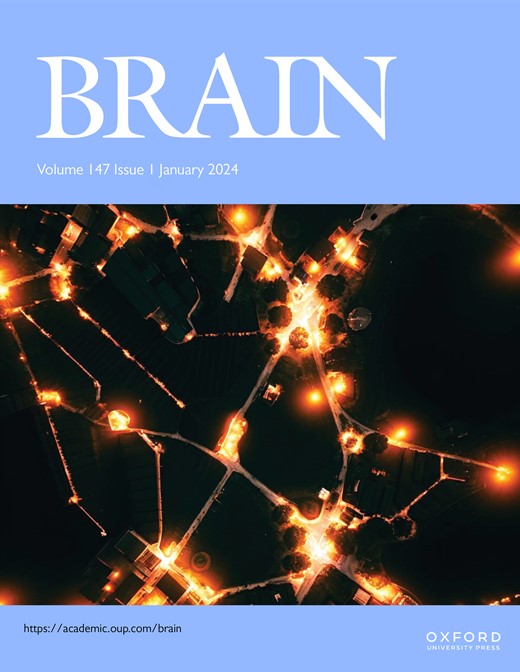Skin intraneural phosphorylated α-synuclein is a highly specific biomarker for early Parkinson's disease.
IF 11.7
1区 医学
Q1 CLINICAL NEUROLOGY
引用次数: 0
Abstract
An early diagnosis of Parkinson's disease (PD) represents a challenge and novel accurate biomarkers are therefore urgently needed. Detection of phosphorylated α-synuclein (p-α-syn) in skin nerve fibers has shown promise as such a marker. However, its accuracy for the identification of PD among patients with early signs of parkinsonism has not been thoroughly explored. In this blinded, multicenter, prospective and follow-up study, 151 patients diagnosed with early-stage parkinsonism (<18 months duration) were enrolled at three tertiary movement disorders centers. Clinical scales were performed and initial diagnoses were reassessed at 18 and 46 months follow-up visits. Skin biopsy, with analysis for neuronal and glial p-α-syn deposits, and olfactory testing were performed at the baseline visit and repeated in 44 patients at the 18 months visit. After the follow-up period, a final diagnosis was reached in 140 patients: PD (n=101; 67% of all screened patients), tauopathies (n=22; 15%), multiple system atrophy (n=5; 3%), vascular parkinsonism (n=4; 3%), essential tremor (n=3; 2%), dystonic tremor (n=2; 1%) and no neurological illness (n=3, 2%). Eleven patients did not fit any clinical criteria and were therefore classified as undefined. Baseline skin intraneural p-α-syn showed a robust diagnostic accuracy (81% sensitivity and 100% specificity) for identifying PD. Importantly, in 30 out of 44 patients not diagnosed with PD until the follow-up intraneural p-α-syn was positive already at baseline. Moreover, the analyses showed a large degree of consistency over time, as the same results at baseline and follow-up were obtained in 42 (96%) of the tested patients. Finally, although olfactory testing at baseline showed a more abnormal score in PD compared to the other groups, its predictive accuracy was more modest (72%). In conclusion, given its high sensitivity, specificity and reproducibility, skin intraneural p-α-syn could become a valuable tool for diagnosing PD at early stages, potentially years before the diagnostic criteria are met, and for differentiating PD from atypical parkinsonism. In contrast, olfactory function, although more impaired in PD than in non-PD patients, only seems to have a more limited diagnostic accuracy.皮肤神经内磷酸化α-突触核蛋白是早期帕金森病的高度特异性生物标志物。
帕金森病(PD)的早期诊断是一个挑战,因此迫切需要新的准确的生物标志物。在皮肤神经纤维中检测磷酸化α-突触核蛋白(p-α-syn)已显示出作为这样一种标记物的希望。然而,其在帕金森早期症状患者中识别PD的准确性尚未得到充分探讨。在这项盲法、多中心、前瞻性和随访研究中,151名诊断为早期帕金森病(病程<18个月)的患者入组了三个三级运动障碍中心。在18个月和46个月的随访中进行临床量表和重新评估初步诊断。在基线访问时进行皮肤活检,分析神经元和胶质p-α-syn沉积物,并进行嗅觉测试,并在18个月的访问中重复44例患者。随访期后,140例患者获得最终诊断:PD (n=101,占所有筛查患者的67%)、牛头病(n=22,占15%)、多系统萎缩(n=5,占3%)、血管性帕金森病(n=4,占3%)、特发性震颤(n=3,占2%)、肌张力障碍震颤(n=2,占1%)和无神经系统疾病(n= 3.2%)。11例患者不符合任何临床标准,因此被归类为未定义。基线皮肤神经内p-α-syn在识别PD方面显示出强大的诊断准确性(81%的敏感性和100%的特异性)。重要的是,44名患者中有30名直到随访后才被诊断为PD,神经内p-α-syn在基线时已经阳性。此外,随着时间的推移,分析显示了很大程度的一致性,因为42名(96%)测试患者在基线和随访时获得了相同的结果。最后,尽管嗅觉测试在基线时显示PD的异常评分高于其他组,但其预测准确性较低(72%)。总之,由于其高灵敏度、特异性和重复性,皮肤神经内p-α-syn可能成为早期诊断PD的有价值的工具,可能在满足诊断标准之前几年,并用于区分PD与非典型帕金森病。相比之下,嗅觉功能,虽然PD患者比非PD患者受损更严重,但似乎只有更有限的诊断准确性。
本文章由计算机程序翻译,如有差异,请以英文原文为准。
求助全文
约1分钟内获得全文
求助全文
来源期刊

Brain
医学-临床神经学
CiteScore
20.30
自引率
4.10%
发文量
458
审稿时长
3-6 weeks
期刊介绍:
Brain, a journal focused on clinical neurology and translational neuroscience, has been publishing landmark papers since 1878. The journal aims to expand its scope by including studies that shed light on disease mechanisms and conducting innovative clinical trials for brain disorders. With a wide range of topics covered, the Editorial Board represents the international readership and diverse coverage of the journal. Accepted articles are promptly posted online, typically within a few weeks of acceptance. As of 2022, Brain holds an impressive impact factor of 14.5, according to the Journal Citation Reports.
 求助内容:
求助内容: 应助结果提醒方式:
应助结果提醒方式:


